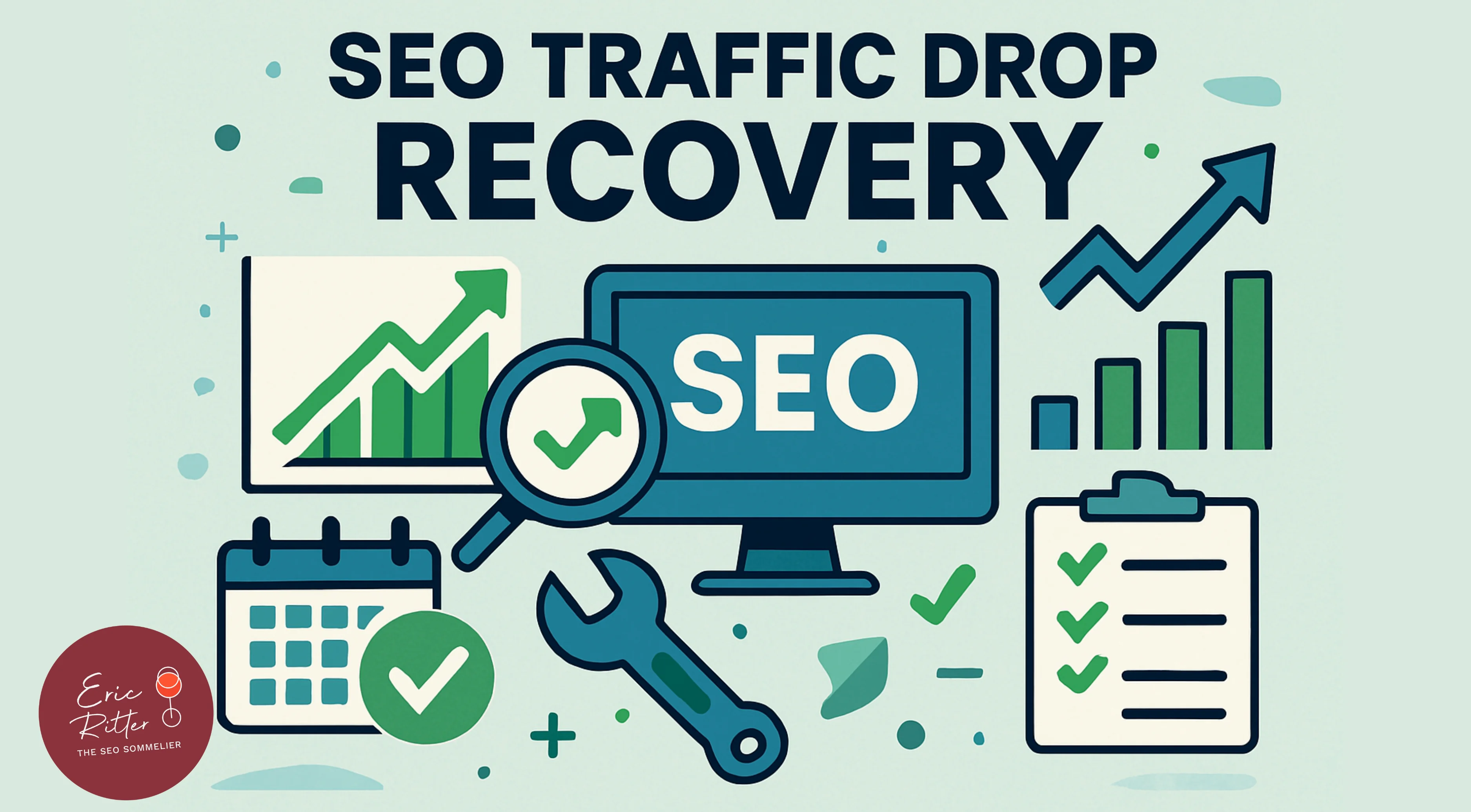SEO Traffic Drop Recovery Guide: Your Game Plan to Bounce Back
SEO traffic drops can feel like the wind has suddenly been knocked out of your digital sails. It’s alarming, frustrating, and can throw off your entire strategy. But fear not! Just like a seasoned winemaker knows how to handle an unexpected corked bottle, you too can navigate the drops in your SEO performance. The key? Understanding why it happened and taking the right steps to recover.
In this guide, we’ll walk you through a structured recovery plan—step by step—just like uncorking a bottle of wine and inspecting its clarity before taking that first sip. You’ll learn how to track down the root causes, make the right fixes, and get your site back on track. Whether it’s a technical issue, content update, or external factor, this SEO Traffic Drop Recovery Guide will equip you with the tools to restore your website’s ranking and bring back that steady flow of traffic. From documenting everything to keeping your team informed, these actionable steps will guide you in diagnosing the issue, making the right fixes, and returning your site to its prime.
The SEO Traffic Drop Recovery Guide

Let’s go over each step of this guide with actionable items you can implement right away to get your traffic back on track.
Step 1: Document Everything
Before you can recover from a drop in SEO traffic, it’s crucial to understand what happened and when. Documenting everything is your first step toward identifying the root cause. By keeping track of Google updates, site changes, and analytics trends, you’ll be able to correlate drops with possible causes. This is your baseline, your map to guide you through the recovery process.
Action Steps:
- Keep a record of Google updates: Algorithm changes from Google can affect your rankings.
- Monitor site changes: Identify if recent redesigns or URL modifications have impacted your traffic.
- Track analytics trends: Compare traffic year over year to account for seasonality and identify patterns.
Helpful Links:
Pro Tip: Use Google Search Console alongside Google Analytics for deeper insights into indexing issues, penalties, or manual actions that could be affecting your site.
Step 2: Prioritize Fixes by Impact
Now that you’ve documented the situation, it’s time to prioritize the fixes that will have the most immediate effect. Some issues, like technical problems, require urgent attention, while others, such as content optimization, will take more time to yield results. By addressing the most impactful issues first, you ensure that your efforts move the needle quickly.
Action Steps:
- Tackle critical technical issues: Make sure your site is indexed correctly and check for server issues like 404 errors and slow load times.
- Focus on content optimization: Update outdated content, improve its quality, and ensure your site demonstrates expertise, authority, and trustworthiness (E-E-A-T).
- Improve internal linking: Strengthen your internal linking structure to help Google understand the hierarchy and importance of your pages.
Helpful Links:
Pro Tip: Start by addressing site speed. Slow load times are a major SEO penalty. Tools like Google PageSpeed Insights can give you specific suggestions to improve performance.
Step 3: Create a Timeline
Some fixes will show immediate results, while others will take weeks to reflect in your traffic data. This step helps you set realistic expectations and allows you to track changes over time. Recovery is a gradual process, so creating a timeline will help you stay on track and measure progress effectively.
Action Steps:
- Set realistic goals: Understand that some changes will have immediate effects, while others (like content updates) will take more time.
- Track progress weekly: Regularly check Google Analytics and Search Console to monitor changes and improvements.
- Adjust as needed: If your traffic isn’t recovering as expected, revisit the areas that need more attention.
Pro Tip: Give your fixes at least 4-6 weeks to show results. SEO recovery is a marathon, not a sprint, so be patient and stay the course.
Step 4: Monitor & Adjust
SEO recovery isn’t a one-time effort; it requires ongoing monitoring and adjustments. Just like continually tasting wine as it ages, you need to track your progress and make necessary adjustments based on real-time data. Regularly monitoring your site’s performance ensures that you can tweak your strategy as needed.
Action Steps:
- Use Google Analytics and Search Console: Use these tools to monitor your recovery progress week-by-week.
- Monitor competitors: Keep an eye on your competitors and adjust your strategy to stay ahead of the race.
- Adjust strategy based on findings: Be flexible and act swiftly. If something isn’t working, pivot and try new tactics.
Helpful Links:
Pro Tip: Use tools like Ahrefs or SEMrush to analyze your backlink profile. A lack of quality backlinks can significantly impact your recovery, so ensure you’re building and maintaining a strong backlink strategy.
Step 5: Keep Stakeholders Informed
Effective communication is essential during an SEO recovery process. If you’re working with a team, keeping everyone updated ensures that expectations are managed and tasks are being executed efficiently. Clear communication can make the recovery process smoother and help maintain team morale.
Action Steps:
- Use project management tools: Keep track of tasks, fixes, and expected timelines in a centralized location.
- Provide regular updates: Ensure your team and stakeholders are kept in the loop on progress and setbacks.
- Set clear expectations: If recovery is taking longer than expected, explain why and outline the next steps.
Helpful Links:
Pro Tip: Consider setting up an SEO dashboard in Google Looker Studio to make progress more visual and accessible to all stakeholders.
Bonus Tips for Long-Term SEO Health
While the above steps are essential for recovering from a traffic drop, it’s always a good idea to adopt long-term strategies for maintaining your site’s SEO health.
- Invest in Quality Content: High-quality content should be the backbone of your SEO strategy. Regularly update blog posts, case studies, and product pages to keep them relevant and competitive.
- Build Strong Backlinks: Backlinks are like endorsements for your site. Develop a strategy to earn quality backlinks from authoritative sites in your industry.
- Stay Updated with Google’s Algorithm: Google’s algorithms are constantly evolving. Stay informed about core updates and adjust your strategy accordingly. Sign up for SEO news outlets like Moz or Search Engine Journal to keep ahead of the curve.
Why This SEO Recovery Plan Is Your Secret Weapon
Navigating the SEO recovery process requires a strategic, hands-on approach. This guide will walk you through a proven, step-by-step recovery plan to diagnose, address, and overcome traffic drops. By following this plan, you’ll not only restore your website’s performance but also build a more resilient SEO strategy, improve your rankings, and drive quality traffic that converts. Cheers to your SEO success!
Download the SEO Traffic Recovery Guide Now
Ready to take your SEO recovery to the next level? Download the full guide to get a handy PDF version of the step-by-step plan, actionable steps, and pro tips to help you recover your traffic and boost your rankings. If you’re looking for a more personalized assessment, contact Eric Ritter, The SEO Sommelier, for a Neighborly Roadmap tailored to your business.



